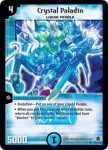In my earlier post, I discussed the basics of Duel Masters Trading Card Game. Now, I am going to brief you about the game setup, and the steps a player must follow on his turn.
Deck Shuffling:
Before the game begins, each player must shuffle his/her own deck. Then each player should present his deck to the opposing player for any additional shuffling or cutting. If the opposing player shuffles the deck, you may cut your deck one last time. If he cuts, then you may shuffle your deck again.
The Setup:
The game play mat and the hand have already been discussed in the basic of Duel Masters card game. Once, the deck shuffling has been performed, each player must put the top five cards from his deck into his shields zone, and then draw five cards to form his hand. The point to be noted here is that the cards in the shields zone are put face down without looking.
The Turn:
You may do a coin toss to decide who should go first. The player who goes first does not draw the card the first turn. The other player gets to draw a card the first turn, in order to compensate the fact of the other player taking the turn first.
Each turn comprises of the following steps; untapping any creatures in the Battle Zone, drawing a card, playing your mana, summoning creatures and/or casting spells, attacking with your creatures in the Battle Zone, end your turn. These steps are explained below:
– Untapping any creatures in the Battle Zone/ cards in the Mana Zone
A card is referred to as ‘tapped’ when it is turned 90 degrees towards right, in order to show that it is being used. At the start of each of your turns, you untap (turning the card straight or 90 degrees towards left) any tapped creatures in the Battle Zone and untap all your cards in the Mana Zone. Usually, you will not have any tapped creatures in the Battle Zone unless you have played a couple of turns and attacked your opponent.
There are occasions where some cards effects can prevent a player from untapping his mana cards or creatures in the Battle Zone, but it is not important now.
– Drawing a card
Drawing refers to picking the top card of your deck and adding it to your Hand. At the start of each of your turns, you have to draw top of card of your deck with the exception of turn one, where the player going first does not draw.
– Playing your Mana
The next step is to play your Mana. You may choose to add a card to your Mana Zone from your hand. There is no limit to a number of cards you can have in your Mana Zone. The step of playing your mana is optional. In the later stages of the game, when you have enough mana, you will find skipping this step useful.
Note that each card in your mana gives only one mana. Moreover, cards in your Mana Zone are put upside down, so that the mana number faces you. Each card gives you one mana of the civilization to which it belongs. For example, if you put a Light card in your Mana Zone, it will generate one light mana. In addition, any card effects for the card that is being put in the Mana Zone are ignored. In order use a mana card, you ‘tap’ it. A tapped mana card cannot be reused, and remains tapped until the start of your next turn (until otherwise a spells says so).
– Summoning Creatures and/or casting Spells
The next step is to use your mana cards to summon creatures and/or cast spells. There is no limit to the number of creatures you summon and spells you cast each turn. It all depends upon your Mana Power. In order to summon a creature or cast spells, you need to pay the mana cost for it. The mana cost is written on the top left corner of the card.
To explain it better, we take the example of ‘Bolmeteus Steel Dragon’, which is a Fire creature, with a 7000 power, and has a mana cost of 7. In order to summon this creature in the Battle Zone, you need to have at least 7 untapped cards in the Mana Zone with at least one Fire card. You must first tap one Fire civilization card in the Mana Zone, and then tap 6 more cards of any civilization in order to summon this creature. All creatures are put into the Battle Zone untapped; until otherwise, some card effects say so.
– Attacking your opponent with your creatures
The next step is to attack your opponent with the creatures in the Battle Zone. The creatures that have been summoned this turn have “summoning sickness”, meaning they cannot attack this turn. However, is later editions of Duel Masters card series, a new card effect has been introduced know as ‘Speed Attackers’. The creatures having this ability do not have summoning sickness and can attack the same turn they were summoned. We will discuss other card mechanics later.
You may either choose to attack your opponent’s tapped creatures (some card effects let you attack untapped creatures as well), or break his shields with your creatures. Breaking a shield is termed as ‘attacking your opponent’. Once all of your opponent’s shields have been broken, it only takes one successful attack to finish your opponent and win the game. In order to attack with your creature, you tap it, do any card effects that it says, and choose what you are attacking (either one of your opponent’s creatures or his shields). There are creatures that can break more than one shield with a single attack. A tapped creature remains tapped until the start of your next turn, unless some card effects instruct otherwise.
You can attack with any number of creatures (in the Battle Zone) each turn, provided they can attack. This also means you can choose not to attack.
– Ending your turn
The last step of your turn will be to declare the ‘end’ of it.
In this post, I have explained the procedure of playing your turn with a sneak peek into the basics of Duel Masters Trading Card Game. If you already are a duelist, you might want to buy or sell Duel Masters cards.















